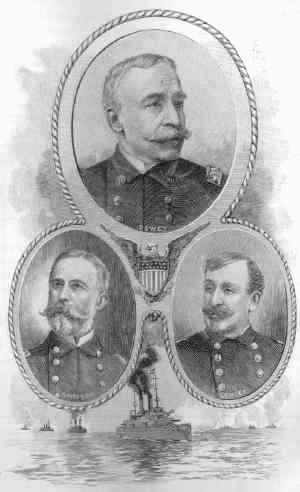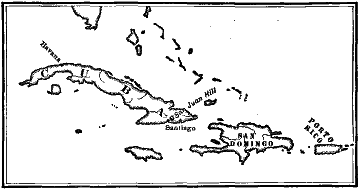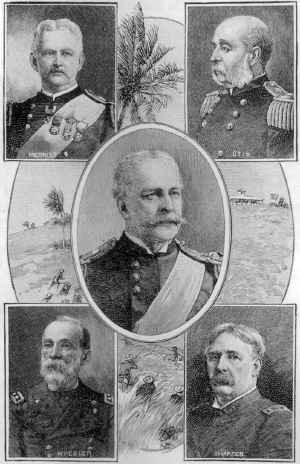Resource Center OLLibrary
|
374 |
|
[1898 |
and urged that the whole question should be referred to an
arbitration committee chosen by different nations (§ 374).
This proposal the United States declined to accept. Later, we
raised the wreck of the Maine (1912), and an examination
confirmed the opinion of the court in regard to the mine.
413. The President's Message; the Resolutions
adopted by Congress. In April (1898) President McKinley sent a
special message to Congress. He declared that in the "name of
humanity," in the "name of civilization," and "in behalf of
endangered American interests," the "war in Cuba must stop."
Shortly afterward both Houses of Congress
resolved (April 19, 1898) "that the people of Cuba are, and of
right ought to be, free and independent." Furthermore, Congress
demanded that Spain should give up all sovereignty over Cuba; in
case Spain refused, the President was authorized to use the land
and naval forces of the United States to compel the Spaniards to
leave the island.
Finally, Congress resolved that when peace
should be made in Cuba, we would "leave the government and control
of the island to its people." Later, however, Congress resolved
(1902) that in case of necessity, the Cubans must admit our right
to act as guardians of their liberty (§ 419).
414. We prepare for War with Spain (1898);
the Call for Volunteers; the Call for Money; the Navy; War
declared. Spain refused to grant our demands and we determined
to fight.
The President called for 200,000 volunteers. A
million men stepped forward, saying, "Here am I; take me." Some of
these men had been Union soldiers in the Civil War, while others
had fought on the side of the South; but now they were eager to
stand side by side and fight against Spain.
Furthermore, our people knew that in war money
was as necessary as men; so when the government wished to borrow a
large sum great numbers at once offered to lend it seven times as
much as it asked for. They also declared their willingness to pay
the heavy taxes that would be needed.1
1 The government
asked for a loan of $200,000,000, and raised about $200,000,000
more, every year as long as it was required.

NAVAL COMMANDERS
Dewey
Samson & Schley
|
376 |
|
[1898 |
In a contest with Spain the navy would
naturally take the most prominent part. The President sent Captain
William T. Sampson.1 with a fleet of war ships to
blockade Havana and other ports of Cuba. He also ordered Commodore
W. S. Schley2 to organize a "flying squadron" of fast,
armed steamers to be used as occasion might demand. Congress then
declared war (April 25, 1898).
415. The Battle of Manila. Commodore
George Dewey, who had been with Farragut at the battle of New
Orleans (§ 334), was then in command of our Asiatic squadron
at Hongkong, China. The President ordered him to go to Manila, the
capital of the Philippines (Map, p. 380), and "capture or destroy"
the Spanish squadron which guarded that important port. Our plan
was to attack Spain through her colonies of Cuba and the
Philippines and so strike her two heavy blows at the same time,
one on one side of the world, the other on the other.
Commodore Dewey had only six ships of war. The
Spaniards at Manila held a fortified port; they had twice as many
vessels as Dewey had, but our squadron was superior in size and
armament; last of all, the enemy, though brave men and good
fighters, had never learned how to fire straight.
On May 1, 1898, Commodore Dewey reported that he
had just fought a battle in which he had destroyed every vessel of
the Spanish squadron without losing a man. A French officer, who
witnessed the fight, said that the American fire was "something
awful" for its "accuracy and rapidity."
The "Hero of Manila" was promoted to the rank of
rear admiral; after the war he was made admiral (1899), and
Captain Sampson and Commodore Schley were made rear admirals.
416. Commodore Schley discovers Cervera's
Squadron. Shortly before the battle of Manila Admiral Cervera
left the Cape Verde Islands with a Spanish squadron of seven war
ships. Nobody in America knew whether Cervera was headed for Cuba
or whether he meant to shell the cities on our eastern coast.
1 Captain Sampson had
the rank of Acting Rear Admiral.
2 Schley (sly or schlä)
|
1898] |
|
377 |
|
Commodore Schley set out with his
"flying squadron" (§ 414) to find the enemy. The
Commodore discovered that the Spanish ships had entered
the harbor of Santiago on the southeast coast of Cuba. He
said with a grim smile, "They will never get home." They
never did. 
MAP OF CUBA AND NEIGHBORING ISLANDS The entrance to the harbor of
Santiago is long, narrow, and crooked; it was also
protected by land batteries and submarine mines. Our
ships could not get at the enemy. |
|
378 |
|
[1898 |
|
steep heights of El Caney and San Juan, overlooking
the city of Santiago. In spite of defenses made of barbed
wire, they drove the Spanish, with heavy loss, pellmell
into the city. |

ARMY COMMANDERS
Merritt, Otis,
Miles,
Wheeler & Shafter
 Not
long after Captain Sampson left, a great shout went up
from the Brooklyn: "The Spaniards are coming out
of the harbor!" Both sides opened fire at the same moment
(July 3, 1898). But the Spanish Admiral's squadron of six
vessels proved to be no match for our fleet of six
vessels, comprising four powerful battle
ships.1 Such a condition could have but one
result.
Not
long after Captain Sampson left, a great shout went up
from the Brooklyn: "The Spaniards are coming out
of the harbor!" Both sides opened fire at the same moment
(July 3, 1898). But the Spanish Admiral's squadron of six
vessels proved to be no match for our fleet of six
vessels, comprising four powerful battle
ships.1 Such a condition could have but one
result.


